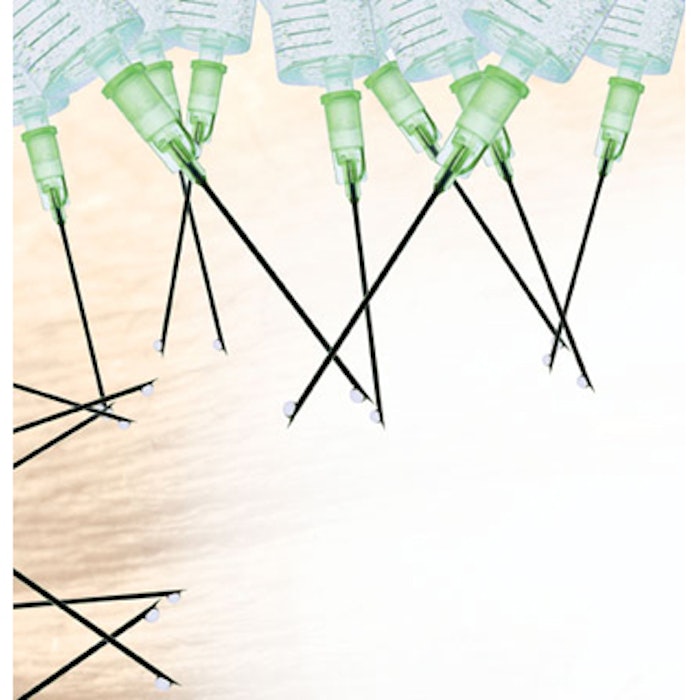
When medical aesthetic practices first began to use the term “Liquid Facelift” to describe the use of fillers and botulinum toxins for facial rejuvenation, there was some discomfort in the industry. Many practitioners were wary of suggesting that patients could achieve results comparable to a facelift nonsurgically, and the outcomes were not always ideal. But with experience, new indications and improved techniques, outcomes have improved significantly. More recently, we’ve learned that injectable treatments not only make the face look younger but can make it behave in a more youthful fashion as well.
Increased strain or compression in the perioral region among older patients changes the appearance of this area, causing more dynamic lines and visible muscle movement, according to a University of Pennsylvania study published in September 2014 in PRS Global Open. “With expressions like lip pursing, strain in the nasolabial fold increases along with asymmetry compared to younger patients,” says study co-author Ivona Percec, MD, PhD, assistant professor of plastic surgery, associate director of cosmetic surgery and director of basic science research in the division of plastic surgery at the University of Pennsylvania.
In April, Dr. Percec presented data from a new study at The Aesthetic Meeting 2018 in New York City. This study compared the naturalness of expression in 30 patients (40-65 years of age) before and after treatment to the nasolabial folds and marionette lines with Galderma’s Refyne and Defyne HA fillers. She and her colleagues found that following treatment, the strain in the perioral area decreased, and they were able to provide a more youthful contour to the face that preserved natural expressions when patients pursed their lips, grimaced and smiled.
“Using just 1cc of filler to that region in combination with a few units of neurotoxin can dramatically decrease the amount of strain in that area and increase patient satisfaction,” says Dr. Percec. “In addition, with the Defyne and Refyne flexible gels, we can maintain and/or improve the dynamic motion and naturalness of expression.”
Gauging Satisfaction
For years, practitioners have reported high satisfaction rates with full-face injectable treatments. That anecdotal evidence is supported by findings of the HARMONY study (Aesthetic Surgery, April 2018). “This was the first prospective study to objectively analyze satisfaction,” says study co-author Vic Narurkar, MD, founder of the Bay Area Laser Institute in San Francisco. “We looked at the face as a whole and treated the full face with a combination of Botox and fillers. We used Voluma in the mid-cheek; Juvéderm Ultra and Ultra Plus in the lower face, and then we used Botox in the upper face.”
At four months, 99 percent of patients rated themselves as “improved” or “much improved” on the Global Aesthetic Improvement Scale, and self-perceived age decreased from 0.2 years older than actual age at baseline to 4.6 years younger at month 4.
But safely achieving natural-looking outcomes requires experience, a keen aesthetic eye and a good understanding of how these individual products behave and interact with one another.
“We have been using HA fillers for 14 years and we certainly have evolved from just filling the nasolabial folds,” says Susan Weinkle, MD, a dermatologist in Bradenton, Florida, and co-author of the HARMONY study. “We’ve learned to treat the overall volume and shape of the face, but in doing so we have learned some lessons about making sure that all of the units of the face remain in balance.”
Maintaining Balance
A rush to try new treatment options has, at times, left patients with less-than-stellar outcomes. “We’ve sent people out with cheek bones that were way too prominent, be-cause we failed to recognize that if you overinflate one area, it can have a negative effect on another area,” says Dr. Weinkle. “For example, if you overbuild that zygomatic area of the cheek, the eyes look much smaller.”
To achieve natural-looking results, injectors need to remember the golden ratio. “Your face should be five eyes wide, and the distance and the width of the face should be greatest among the zygomatic arch region,” says Dr. Weinkle. “You always have to keep your eye on those proportions—upper third, middle third, lower third—and you have to look at the face dynamically and adynamically as you inject.
“When you’re doing a neuromodulator, you also have to look at the face dynamically so you see where the maximum muscle activity is. This is particularly true in the glabella because people have asymetrical muscles—they may be stronger on one side,” adds Dr. Weinkle. “You can’t inject cookbook. You have to watch the muscle activity before marking the injection points.”
Study the patient’s dynamic face not only prior to injections but during treatment, suggests Dr. Percec. “I watch how the face moves as the patient talks, and then have them express things like a grimace, a snarl or a big, open-mouth smile,” she says. “If you’re trying to fill something that is only visible during animation, you have to have the patient animate to see it as you’re injecting.”
Understanding the Products
With so many HA fillers now on the market—each with its own characteristics—practitioners must become versed in the different products. “In 2004, we had Restylane. Now we have 12 HA fillers in our cupboard and we’re about to have more,” says Dr. Weinkle. “To be the most skilled injector, it’s important to recognize the significant variability among the products.”
Today, injectors may use three or four different fillers plus toxins in one patient, and patients regularly come in for touch-ups or retreatment. This raises the concern of potential complications due to product layering or mixing. “We know very little about how these fillers interact with one another,” says Dr. Percec. “Even if they are all HA-based, they all behave differently and their cross-linking technologies are all slightly different. So the question is, when we layer these one on top of the other, do the fillers interact with each other and/or the tissue in a way that has a negative effect or a beneficial effect?”
Dr. Narurkar regularly uses a combination of HA fillers in his patients and has also combined different classes of fillers. “I’ve used HA fillers to create more definition in patients who already had Sculptra. Similarly, we’ve had patients with Radiesse followed with an HA filler, and there haven’t been any issues. But none of this has been studied objectively. This is all anecdotal.
“Complications occur,” he continues. “But often you don’t know what prompted them.”
Infection is the main concern when you have multiple injection sites and multiple treatments performed over years, says Dr. Percec. “Early on, injectors were a little too cavalier. They would use an alcohol wipe and not make patients take their makeup off, which I believe increases the risk of developing biofilm and potential infection,” she says. “Overall, the more product you inject, the higher the likelihood of introducing bacteria.”
The sheer volume of filler being implanted into the face also raises some concerns. “If patients already have product in their faces and are prone to inflammation or transient infections, such as sinusitis, or undergo dental procedures—that transient bacterial load or viral load can inflame the HA filler,” says Dr. Percec.
Similarly, seasonal allergies can activate the filler and cause inflammation. “These fillers are dynamic in the sense that tissues respond and interact with them, and we’re just at the beginning stages of learning how that affects patients,” says Dr. Percec. “In the past, a patient would get one syringe of Restylane or Juvéderm in their nasolabial folds, and there was very little likelihood that something was going to happen. But when you have all these different areas of the face being injected on a more frequent basis, you’re going to see different kinds of biological behavior.”
Specific Concerns
Some patient-specific concerns are well documented. For example, patients who have undergone rhinoplasty or other nasal surgeries are at higher risk of intravascular injuries and skin necrosis.
“If you’re doing off-label filler injection in the nose, you have to ask if the patient has had surgery in this area,” says Dr. Narurkar. “Because the scar tissue can compromise the vasculature. This is less of a concern with facelifts. In fact, we do fillers after facelifts all the time because a facelift often doesn’t address loss of volume. But I like to wait a good month or even up to a year after a facelift to do fillers.”
Fillers actually can help alleviate one concern unique to facelift patients. “They often have significant atrophy in the preauricular region because when the flap is elevated for the lift, the fat in the area sometimes dies, “ Dr. Weinkle says. “When that happens, you see pronounced atrophy down the road, so you might choose to re-volumize that area.”
Dr. Percec also encourages injectors to consider the patient’s tissue when selecting the best filler. “If you use a high G-prime filler—one that has high lifting capacity—in a patient who is very gaunt or who is elderly and has paper thin tissue, it is more likely to be lumpy and bumpy and look unnatural. So you want to select a more flexible gel—something softer that will lift their tissues but not create a bumpy appearance.”
Conversely, she reaches for a high G-prime filler when treating patients with heavier faces. “A thinner or very flexible filler in a patient with a heavier face and thick skin is going to be almost imperceptible,” she says.
Ask older patients about anticoagulant use. “Almost all of my patients down here in Florida are on some kind of anticoagulant. I do not stop anticoagulant use of any type to inject a filler or Botox,” says Dr. Weinkle. “I explain to the patient they may have a higher incidence of bruising. But bruising is a manageable problem. I think it is very important to reiterate: ‘Do not stop anticoagulant use for a cosmetic procedure.’”
Perfecting the Technique
With so many new indications and products, ongoing training is essential. Following are some basic guidelines to help injectors achieve the best outcomes.
When combining toxins and filler, it’s best to start with the filler injections to reduce the risk of migration of the botulinum toxin, notes Dr. Narurkar. “The rule of thumb is always do fillers first, but they can be done in the same session,” he says.
Start the fillers in the midface. “We noticed during the pivotal Voluma trials that when we filled the midface, there was collateral improvement of both the tear troughs and the nasolabial folds—even without putting any filler in those areas,” says Dr. Narurkar. “So we always start in the midface, then the temples, then the marionette lines, then the jaw line. At the very end, we treat the perioral area.”
To avoid over-filling, be judicious and bring patients back more frequently to slowly build up the correction they need. “I call it the building of the platform,” says Dr. Percec. “We bring people back more frequently and do
a little less each time. They get more natural result with less downtime.”
She asks patients to return every two to four weeks until the desired correction is achieved. “Once we’re happy with the correction, I like to maintain it every six months,” says Dr. Percec. “Even if the fillers are still there—maybe they’ve lost 20 percent of the correction—I’d rather do a little touch-up at the six-month mark than a full reinjection a year or 18 months later.”
She encourages new injectors to take their time in introducing new fillers and areas of injection. She teaches her residents to start with one middle-range HA filler—Restylane, for example—and focus on on-label indications, such as the nasolabial folds. “Once you feel confident with your injection technique, move to more sophisticated areas and branch out in your use of fillers,” says Dr. Percec. “Our market is getting much more sophisticated and our injectors are getting much more sophisticated. This requires a lot more training on our part because the standards are getting higher, and we have a lot more tools in our toolbox.”
Inga Hansen is the executive editor of MedEsthetics.
Image Getty Images











